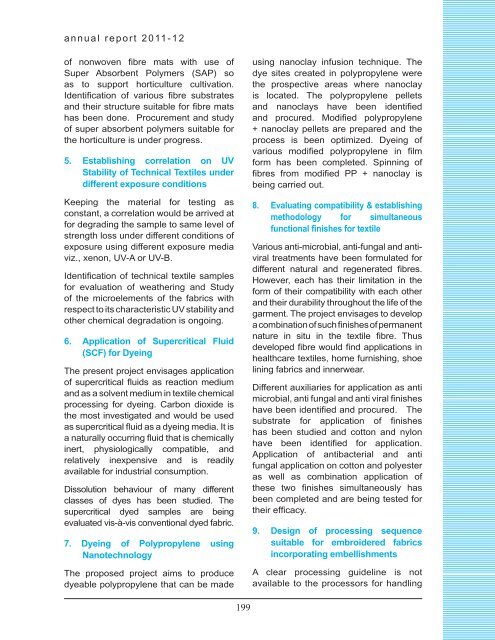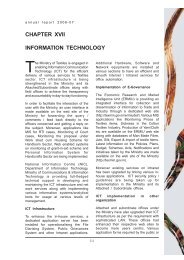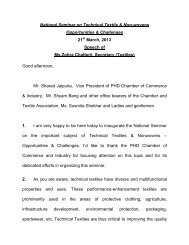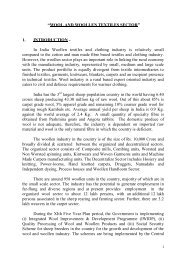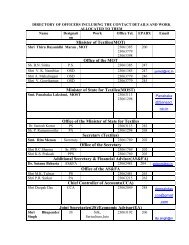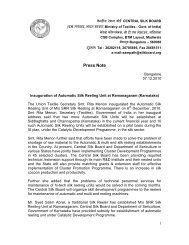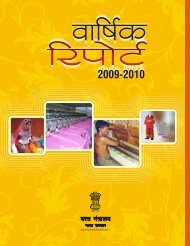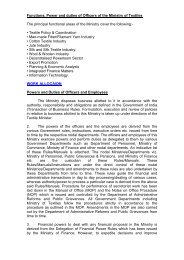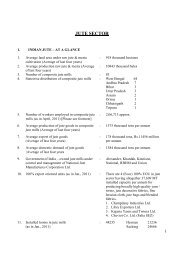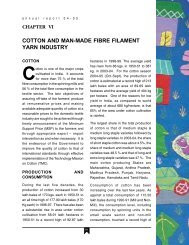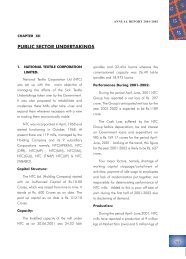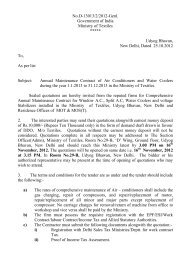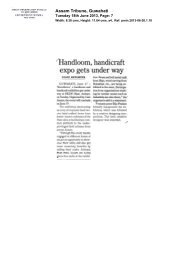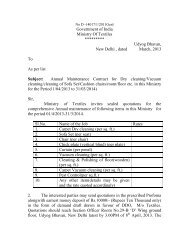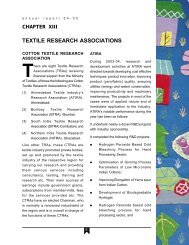chapter viii wool & wollen textiles industry - Ministry of Textiles
chapter viii wool & wollen textiles industry - Ministry of Textiles
chapter viii wool & wollen textiles industry - Ministry of Textiles
Create successful ePaper yourself
Turn your PDF publications into a flip-book with our unique Google optimized e-Paper software.
annual report 2011-12<br />
<strong>of</strong> nonwoven fibre mats with use <strong>of</strong><br />
Super Absorbent Polymers (SAP) so<br />
as to support horticulture cultivation.<br />
Identification <strong>of</strong> various fibre substrates<br />
and their structure suitable for fibre mats<br />
has been done. Procurement and study<br />
<strong>of</strong> super absorbent polymers suitable for<br />
the horticulture is under progress.<br />
5. Establishing correlation on UV<br />
Stability <strong>of</strong> Technical <strong>Textiles</strong> under<br />
different exposure conditions<br />
Keeping the material for testing as<br />
constant, a correlation would be arrived at<br />
for degrading the sample to same level <strong>of</strong><br />
strength loss under different conditions <strong>of</strong><br />
exposure using different exposure media<br />
viz., xenon, UV-A or UV-B.<br />
Identification <strong>of</strong> technical textile samples<br />
for evaluation <strong>of</strong> weathering and Study<br />
<strong>of</strong> the microelements <strong>of</strong> the fabrics with<br />
respect to its characteristic UV stability and<br />
other chemical degradation is ongoing.<br />
6. Application <strong>of</strong> Supercritical Fluid<br />
(SCF) for Dyeing<br />
The present project envisages application<br />
<strong>of</strong> supercritical fluids as reaction medium<br />
and as a solvent medium in textile chemical<br />
processing for dyeing. Carbon dioxide is<br />
the most investigated and would be used<br />
as supercritical fluid as a dyeing media. It is<br />
a naturally occurring fluid that is chemically<br />
inert, physiologically compatible, and<br />
relatively inexpensive and is readily<br />
available for industrial consumption.<br />
Dissolution behaviour <strong>of</strong> many different<br />
classes <strong>of</strong> dyes has been studied. The<br />
supercritical dyed samples are being<br />
evaluated vis-à-vis conventional dyed fabric.<br />
7. Dyeing <strong>of</strong> Polypropylene using<br />
Nanotechnology<br />
The proposed project aims to produce<br />
dyeable polypropylene that can be made<br />
using nanoclay infusion technique. The<br />
dye sites created in polypropylene were<br />
the prospective areas where nanoclay<br />
is located. The polypropylene pellets<br />
and nanoclays have been identified<br />
and procured. Modified polypropylene<br />
+ nanoclay pellets are prepared and the<br />
process is been optimized. Dyeing <strong>of</strong><br />
various modified polypropylene in film<br />
form has been completed. Spinning <strong>of</strong><br />
fibres from modified PP + nanoclay is<br />
being carried out.<br />
8. Evaluating compatibility & establishing<br />
methodology for simultaneous<br />
functional finishes for textile<br />
Various anti-microbial, anti-fungal and antiviral<br />
treatments have been formulated for<br />
different natural and regenerated fibres.<br />
However, each has their limitation in the<br />
form <strong>of</strong> their compatibility with each other<br />
and their durability throughout the life <strong>of</strong> the<br />
garment. The project envisages to develop<br />
a combination <strong>of</strong> such finishes <strong>of</strong> permanent<br />
nature in situ in the textile fibre. Thus<br />
developed fibre would find applications in<br />
healthcare <strong>textiles</strong>, home furnishing, shoe<br />
lining fabrics and innerwear.<br />
Different auxiliaries for application as anti<br />
microbial, anti fungal and anti viral finishes<br />
have been identified and procured. The<br />
substrate for application <strong>of</strong> finishes<br />
has been studied and cotton and nylon<br />
have been identified for application.<br />
Application <strong>of</strong> antibacterial and anti<br />
fungal application on cotton and polyester<br />
as well as combination application <strong>of</strong><br />
these two finishes simultaneously has<br />
been completed and are being tested for<br />
their efficacy.<br />
9. Design <strong>of</strong> processing sequence<br />
suitable for embroidered fabrics<br />
incorporating embellishments<br />
A clear processing guideline is not<br />
available to the processors for handling<br />
199


